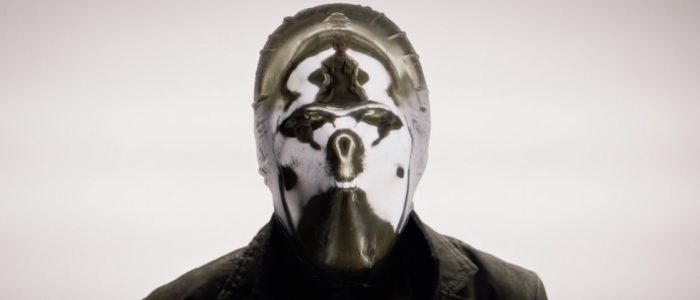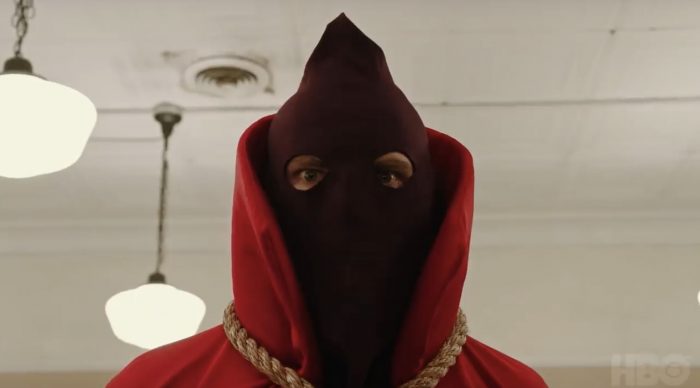
Last year, when showrunner Damon Lindelof posted a letter to Instagram about his upcoming Watchmen series for HBO, he classified it as a “remix.” On the one hand, this was good news for fans who were trepidatious about seeing the greatest comic book story of all time receive another direct sequel or adaptation. On the other hand, remixes already dominate the dance floor in Hollywood. When creators and critics use that word now, it either feels like industry code for a thinly disguised remake (amid all the other official remakes that are currently flooding the market), or it feels like a pejorative term for the repackaged greatest hits of a beloved IP.
By way of an example, this very week, we’ve got a new Terminator movie hitting theaters, which reviewers have likened to The Force Awakens of the franchise. However, if the first two episodes are any indication, that’s not what Lindelof’s Watchmen remix is. Instead, what it looks to be is a fascinating re-contextualization: a show that sets us down on familiar ground but updates it and makes it feel different enough that its echoes of Watchmen and other past superhero tales lay submerged within a fresh story.

Running Out of Ice, But Doing Fine on Eggs
The first episode of Watchmen introduced viewers to a lost episode from American history: namely, the real-life Tulsa Race Riot of 1921, otherwise known as the Black Wall Street Massacre. Two black parents emerge with their son from a movie theater into a disorienting scene where planes are flying in low overhead, smoke is rising up from storefronts, and people are being shot in the street. They’re able to secure passage for their son out of town in the back of a jalopy but they themselves perish in an exploding building.
The boy, who will one day grow up to be an old man in a wheelchair, wakes up in a field just outside of Tulsa as it burns. His car has crashed, its owners are dead, and he is left alone to carry a baby wrapped in a quilt with red and white stripes.
This is America. It’s also Krypton. And Gotham City. Yet the viewer is so caught up in the bedlam of the Black Wall Street Massacre that he or she might not even be cognizant that they’re seeing two modern-day comics myths remixed with real American history.
That’s the mark of a good narrative: it’s so absorbing that you don’t pay much attention to how you’re being fed something old in the guise of something new. Most stories are inspired by something — usually another story, real or fictional — and they invariably follow one of a limited number of plot templates that have already been done before. Watchmen realizes this but it isn’t content to be a surface-level rehash of classic comics moments. It’s filled to the brim with too many other ideas, like shotguns hidden in headboards.
Sure, there are plenty of Easter eggs … sometimes they even take the form of actual egg yolks, arranged like a smiley face with a blood drop in one eye. The crucial difference here is that the show has found a way to place these symbols in an entirely different context. Instead of Cold War nuclear tensions, Watchmen’s Doomsday Clock thrives on 21st-century racial tensions. With its “Black Oklahoma” performance and role-reversed traffic stops (which still end in black men being shot), the show even remixes real-world situations, rendering them strange but familiar.
The first episode’s title, “It’s Summer and We’re Running Out of Ice,” is a line from the Rogers and Hammerstein musical Oklahoma!, but in its own way, it also recalls the heat-wave metaphor in Spike Lee’s Do the Right Thing. That movie celebrated its thirtieth anniversary this summer—the day after the Comic-Con trailer for Watchmen dropped. As much as the world has changed in the last three decades, it feels like the movie’s radio warnings of a heat wave with “no end in sight” have proven oracular, not only in terms of race relations, but in the overall tenor of U.S. political rhetoric.
As The Hollywood Reporter noted in January 2017 (a week after the Inauguration of Donald Trump as the 45th U.S. President), the real-life Doomsday Clock has reached a point now where it is actually closer to midnight than in the Watchmen comic. For the last two years, it’s held at two minutes to midnight.

The Boy Who Would Be Hooded Justice?
Before it starts showing us remixed elements from the original Watchmen comic, the show takes us back to the superhero genre’s roots. Watchmen’s opening silent film, starring Bass Reeves, “The Black Marshal of Oklahoma,” takes the place of the traditional Zorro movie, which has been a part of Batman’s origin ever since Frank Miller’s The Dark Knight Returns #1 hit newsstands in 1986. That same year, writer Alan Moore and artist Dave Gibbons invited readers into the world of Watchmen … and comics have never been the same.
In our breakdown of it over the summer, I noted how the opening seconds of Watchmen’s Comic-Con trailer gave immediate, subtle nods to Superman and Batman. That’s something the show does in its opening minutes, as well. The movie theater is pure Bruce Wayne, while that burning city and the exploding building with the parents in it is pure Kal-El or Superman. Instead of a crashed rocket in a Kansas field, it’s a crashed car in an Oklahoma field where the boy emerges into his new life as an orphan.
Idris Elba may claim he’s “Black Superman” … but in the context of Watchmen, Louis Gossett, Jr. seems a likelier candidate. More specifically, it’s the character Gossett plays, Will, that the show seems to be positioning as its Superman. Though Will has only given us his first name on the show thus far, the IMDb credits list Gossett as playing “Will Reeves.” It’s conceivable that the orphaned Will might have been inspired to adopt Reeves as his surname as he struck out on his own (to fight for truth, justice, and the American way?)
We already know from the Watchmen comic that, in his fictional universe, Hooded Justice was the first-ever costumed hero. He started making public appearances in 1938, which is the same year Superman debuted in Action Comics #1. Furthermore, the name Reeves, and Will’s latter-day use of a wheelchair, serves as a reminder of Christopher Reeve, the actor who played the Man of Steel in the prototypical superhero film, Superman: The Movie, only to later be paralyzed in a horse-riding accident. (The role of Superman was also played by actor George Reeves in the 1950s, another person with a similar name.)
If that weren’t enough, there’s also the fact that American Hero Story — Watchmen’s cheeky, in-universe version of American Horror Story — went and dispelled, right out of the gate, the previously assumed identity of Hooded Justice. If he’s not circus strongman Rolf Muller, as Hollis Mason speculated in his superhero autobiography Under the Hood, then who is he?
American Hero Story seems like it will function as this show’s Tales of the Black Freighter, the comic-within-a-comic that served as a pirate parallel to Watchmen’s main superhero narrative (especially Adrien Veidt’s strand of that narrative). Lindelof has talked about “maneuver[ing] in between the cracks and crevices” of the original Watchmen comic and finding new stories there. In his Instagram letter, he said, “We also intend to revisit the past century of costumed adventuring through a surprising yet familiar set of eyes.”
There’s enough leeway there with Hooded Justice’s identity that the show could easily make him that set of eyes. If Will is 105 years old, that would make him 7 at the time of the massacre in 1921, and 24 at the time of Hooded Justice’s debut in 1938. That’s just the right age for a young superhero in his physical prime, able to leap through windows in a single bound and smash heads bloody on store counters. The Hooded Justice costume, with its rope necklace and pointy hood, even seems like a natural fit for a black orphan who wanted to turn symbols of oppression into superhero emblems.
Opening up a chapter of secret history in the Watchmen world to show the first superhero as African-American would also align with the show’s racial concerns. If rock ’n’ roll became white through cultural appropriation, it’s not a stretch to think the same process might affect superheroes in this alternate reality. There’s still time for Watchmen to wiggle out from under the theory that Will Reeves is Hooded Justice, but I’m willing to bet that the show might follow through on these early clues to show us an ingenious Superman remix with something to say about the hidden heroes and villains of history. Exposing “a vast and insidious conspiracy” at the heart of the police institution, which Angela, a black woman, has heretofore trusted, would certainly give new meaning to the old question, “Who watches the Watchmen?”
Continue Reading Watchmen >>
The post HBO’s ‘Watchmen’ Demonstrates the Right Way to “Remix” a Classic appeared first on /Film.
from /Film https://ift.tt/2MVHpol
via IFTTT
Comments
Post a Comment